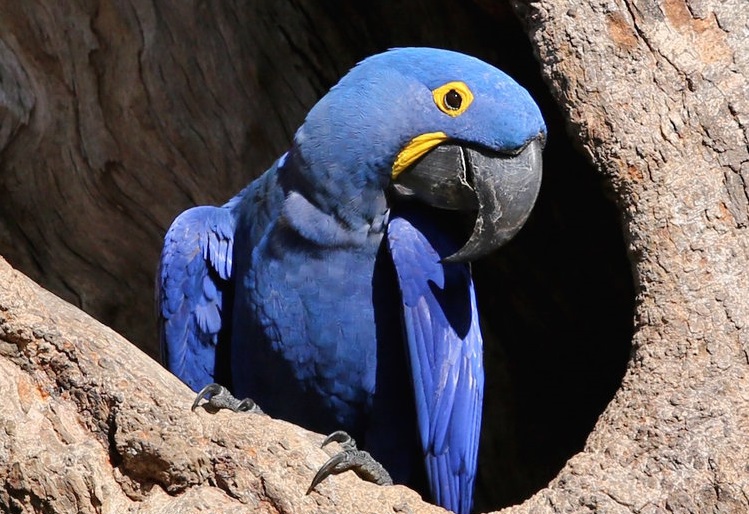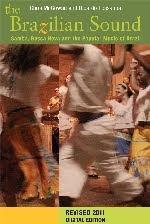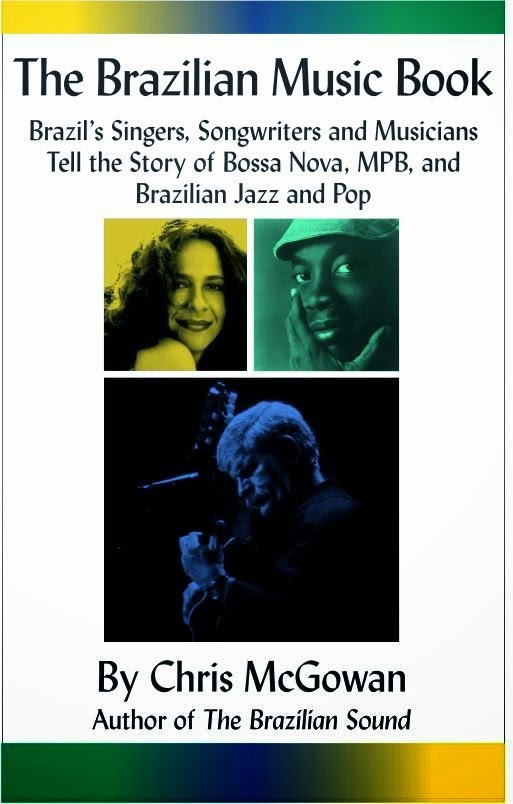Geraldo Azevedo:
The Northeastern Wave
The Northeastern Wave
"After
bossa nova and Tropicália, there was a strong northeastern movement. It didn't
have a name, but I think it was as important."—Geraldo Azevedo
Geraldo Azevedo, like his colleague Alceu Valença, was part
of the "northeastern wave" that enriched MPB in the 1970s. Azevedo—a
singer, songwriter and guitarist—interprets regional styles with a bossa nova
sensibility and sophistication. His light, clear songs center on his voice and
guitar, often acoustic. Geraldo's lyrics evoke earthy romantic love and the
beaches, jangadas, and coconut
trees of the northeastern coast.
Geraldo
Azevedo de Amorim was born on January 11, 1945 in Petrolina, Pernambuco, on the
banks of the São Francisco River. Geraldo grew up in a musical household where
everyone played instruments or sang. "The folklore of the region—maracatu,
coco, repentistas—it's in all of us without our perceiving it," Azevedo
told me. He was a self-taught
musician and started playing the guitar at age twelve. As a teenager, he
listened to Luiz Gonzaga and Jackson do Pandeiro, as well as such diverse
musicians as Johann Sebastian Bach, classical guitarist Andrés Segovia, bossa
guitarist Baden Powell, and romantic crooner Nelson Gonçalves. But it was the
bossa nova singer João Gilberto who inspired Geraldo to become a professional
musician. "He made me more serious about looking into harmony. We didn't
have those [bossa nova] harmonies in Petrolina."
He
began playing with the group Sambossa as a teenager and at eighteen he traveled
to Recife to attend college. While there he joined Grupo Construção, which
included percussionist Naná Vasconcelos, singer Teca Calazans, and two future
members of Quinteto Violado – Toinho Alves (bass) and Marcelo Melo (guitar).
Geraldo Azevedo, "Moça Bonita"
In 1967, Azevedo moved to Rio and formed the group Quarteto Livre (Free Quartet) with Vasconcelos, guitarist Nelson Ângelo, and flutist Franklin da Flauta (Franklin Correa da Silva Neto). They accompanied singer-songwriter Geraldo Vandré in various shows and on his famed protest anthem "Pra Não Dizer Que Não Falei de Flores" (Not to Say I Didn't Speak of Flowers"), also known as "Caminhando," which was censored for ten years after its debut in 1968. Vandré was a hero of the 1960s song festivals who sang protest lyrics against social injustices and Brazil's military dictatorship. Azevedo and Vandré wrote "Canção da Despedida" (Goodbye Song) together and the government banned it for twelve years until it was recorded by Elba Ramalho.
The notorious Institutional Act No. 5 of December 13, 1968 clamped down hard on dissent in Brazil and made it impossible for Vandré and Quarteto Livre to record. Vandré left the country and Azevedo went to prison. Azevedo was not politically militant, but his friendship with loudly dissenting musicians and artists caused him to be clandestinely seized and placed under arrest in 1969. When he came out of prison, after staying for forty-one days, he felt depressed and beaten down and almost gave up music for good. The next year was a bleak year for Azevedo, but near its end he re-encountered Alceu Valença, who gave Geraldo "a force, a strong push" and helped him regain his enthusiasm for music. The two teamed together for a while, co-writing songs (such as the hit "78 Rotações") and entering the musical festivals together
They made their recording debut in 1972 with the joint album Alceu Valença e Geraldo Azevedo: Quadrafônico. It had many memorable songs, including "Talismã" (written by the two of them), and the haunting "Novena," a toada written by Azevedo and Marcus Vinícius. In it, Azevedo poetically evoked the intense Catholicism of his childhood.The two also later collaborated in the O Grande Encontro series, but their styles are generally quite different.
"Novena" from Alceu Valença and Geraldo Azevedo's Quadrafônico
Alceu is a fiery musical alchemist who attempts to be theatrical and mythical,
and Geraldo in general is mellow and down to earth. Valença fuses northeastern
styles with rock and blues, while Azevedo mixes the region's idioms with bossa
nova harmonies and vocal influences and the occasional light pop touch. Both
often favor the northeastern xote
rhythm, which has an affinity with reggae. Azevedo's lilting "Taxi
Lunar" (co-written with Valença and Zé Ramalho) and tender "Moça
Bonita" are based in xote; and his "Petrolina e Juazeiro,"
written with Moraes Moreira, and "Dona da Minha Cabeça" mix xote with
reggae.
Azevedo
placed songs on numerous television novelas over the next few years, which
brought him a great deal of attention. In 1977, he released his first solo LP, Geraldo Azevedo, which had the evocative
Azevedo-Valença tune "Caravana" (Caravan); it was included on the
soundtrack for the Gabriela TV
novela.
After
that, Azevedo recorded albums such as Bicho
de Sete Cabeças (Seven-Headed Animal), De
Outra Maneira (Another Way), and Eterno
Presente (Eternal Present).
Geraldo Azevedo, "Caravana"
Other hits include "Dia Branco"
(White Day), "Arraial
dos Tucanos" (used by the series Sítio
do Pica-pau Amarelo), "Juritis e Borboletas," "Barcarola do
Rio São Francisco," "Chorando e Cantando" (Crying and Singing),
and "Talvez Seja Real" (It Might Be Real). His 1981 album Inclinações
Musicais (Musical
Inclinations) with arrangements by Dori Caymmi and the participation of Sivuca
and Jackson do Pandeiro, included his signature song "Moça
Bonita."
Beautiful
girl, your kiss can
Kill
me without compassion
I
don't know if it's so
Or
it's pure imagination
To
find out, you give me
This
assassin kiss
As
I lie in your woman's arms
In 1984, Azevedo traveled with the late Tancredo Neves,
participating in the Direitas movement for democratic presidential elections in
Brazil. That same year, he was part of the group show Cantoria with Elomar,
Vital Farias and Xangai, a great showcase of northeastern musical traditions
from four of the region's finest musicians. The show resulted in the Cantoria I album, which was followed by Cantoria II four years later.
Alceu Valença, Elba Ramalho, Geraldo
Azevedo and Zé Ramalho's O Grande Encontro
In 1985,
he released the acoustic A Luz do Solo,
which is a great retrospective of his standards up to that point. In the next
decade, he joined Alceu Valença, Elba Ramalho, and Zé Ramalho for the three
well-received O Grande Encontro
albums, between 1996 and 2000. Salve São
Francisco (Save the San Francisco), released in 2010, is a thematic album
devoted to the great San Francisco River, which Geraldo grew up beside and
which is under threat today from dams and diversions of its water.
I interviewed Azevedo at the BMG/Ariola recording studio in Copacabana, when he was laying down vocal and guitar tracks
for "Bossa Tropical," the title song for an upcoming album. Azevedo was
dressed in a green and purple sweatshirt and chewing ginger root because of
a bad cold. He was very friendly and relaxed.
Chris: What have you been up to?
Geraldo: I've
been traveling a lot internationally. In February 1990, I have a show in Paris.
Chris: You have a
growing audience in Europe.
Geraldo: I did the Montreux Jazz
Festival in 1985 and it was very well received. I played with Djavan and Tania
Maria, who were better known, but I did very well.
Chris: You have a
unique fusion of northeastern music with many other types of music. What
musical elements are in your songs?
Geraldo: My work
has a lot of mixing. On the new album, for example, there's a song called
"Sexo Vinte," a pun on seculo
vinte (20th century). It is a mix of xote, which is very related
to reggae, and the Beatles. "Talismã" perhaps originated from the
Gypsies. The songs are inspired and you don't always know what the influences
are.
Chris: Did you have a musical childhood?
Geraldo: In my
house, music was always naturally a part of things. My mother sings
marvelously. My father plays guitar. My brothers all play music. In school, I
always sang at the different parties and festivals. I couldn't enter the
university because I always had shows that interfered with my taking the
entrance exam.
Chris: What were some of your biggest influences?
Geraldo: Bossa
nova and João Gilberto. João Gilberto made me turn professional. He made me
more serious about looking into harmony. We didn't have those [bossa nova]
harmonies in Petrolina. Also [Dorival] Caymmi, Milton [Nascimento], Jobim,
jazz. The Northeast is so much a part of me – Jackson do Pandeiro and Luiz
Gonzaga. The folklore of the region—maracatú, coco, repentistas—is in all of us
without our perceiving it, instinctively. Later, I turned to jazz, the Beatles.
Chris: You
recorded your first album with Alceu Valença, but you had already been in Rio
awhile. How did you career start once you got down there?
Geraldo: I came to Rio before Alceu.
I played with Quarteto Livre, with Naná Vasconcelos and others. We never
recorded an album.
Chris: The military
essentially broke up the group and sent Vandré into exile and you into prison.
You also couldn't record "Canção da Despedida," written with Vandré,
until much later.
Geraldo: My song
"Canção da Despedida" was censored for a long time. At that time, artists
were suffocated. There was cultural chaos. People had to leave the country.
Chris: And you
were thrown into jail.
Geraldo: I was
imprisoned twice. In 1969 for forty-one days and in 1975 for eleven days. The
first time in prison, I was very depressed and beaten down. But I was young and
I could recover.
Chris: Alceu
Valença helped you get back into music.
Geraldo: Alceu
met me in Rio. Alceu gave me a force, a strong push. It was a new musical
movement. I recorded my first record, Alceu Valença and Geraldo Azevedo, in 1971 [it was released the
next year].
Chris: What happened the second time the military imprisoned you?
Geraldo: The
second time, six years later, was more violent. I was blindfolded, tortured. My
jailers asked me to play for them, but I refused. I wasn't going to play for my
torturers. I was never tried. My work didn't have political connotations. It was humanistic, more to the positive
than to the nihilistic, and more to the constructive than the destructive. But
any person looking into cultural and humanistic subjects was persecuted. Some
people died innocently. But, happily, I came through all that. The second time,
I had a very strong spirit, and I left feeling strong, even though my time in
jail was very violent. After I left I decided I would become famous and I
accelerated my work and recorded my first solo album, Geraldo Azevedo, for Som Livre in 1976. Ironically, [President]
Geisel took my album to Germany as being representative of Brazilian culture.
Chris: What do
you think was the impact of the dictatorship and the repression on Brazilian
music?
Geraldo: I think
the dictatorship interrupted a Brazilian cultural cycle and we still haven't
managed to recover. We are still asleep. I think my success has come about
because people sense something more profund and poetic in my music. They have a
lack of cultural inheritance. Rock is empty, alienated. The system presents
alienated music, with the exception of some artists like Cazuza, Lobão, and
Renato Russo.
Chris: There was
exceptional music, by Geraldo Vandré, Edu Lobo, Chico Buarque and so many
others, presented at the great Brazilian music festivals of the 1960s. And then
the military dictatorship stepped in and censored a lot of it.
Geraldo: At the
festivals, there came out such a force. We don't have this now. I think we'll
never recover what we lost, but we can have a new movement with much sweat and
heart.
Chris: You are
one who survived, and have large following, even though you have released a
relatively small number of albums in your four-decade career.
Geraldo: Today I
have a bigger public, especially in the Northeast. Now I select and choose what
I want to do. I'm not so worried about TV appearances, etc. I tried to do a
real commercial album with Mazzola. PolyGram wanted me to do that, and it was
completely unsuccessful and is no longer in the catalog. So, I have to do it
from my heart.
Chris: The music
that was created by you and Alceu Valença and your peers from the Northeast was
a really vital part of MPB.
Geraldo: After
bossa nova and Tropicália, there was a strong northeastern movement. It didn't
have a name, but I think it was as important. Alceu, myself, Zé Ramalho,
Belchior, Elba Ramalho, Fagner, and others.
Chris: Did you
ever imagine being where you are today and having such a long and successful career?
Geraldo: I never thought about being
a musician. Music just carried me away.
_______
Select Discography
Geraldo Azevedo
Geraldo Azevedo. Som Livre, 1977.
Bicho de sete cabeças. Epic/CBS, 1979.
Inclinações musicais. Ariola, 1981.
For all para todos. Ariola, 1982.
Tempo tempero. Barclay/Ariola, 1983.
A luz do solo. Barclay/Polygram, 1985.
De outra maneira. Echo/RCA, 1986.
Eterno presente. RCA, 1988.
Bossa tropical. RCA, 1989.
Berekekê. Geração, 1991.
Ao vivo comigo. Geração/BMG Ariola, 1994.
Futuramérica. BMG, 1996.
Raízes e frutos. BMG, 1998.
Hoje amanhã. BMG, 2000.
O Brasil existe em mim. Sony/BMG, 2007.
Salve São Francisco. Biscoito Fino, 2010.
Geraldo Azevedo and Alceu Valença
Alceu Valença & Geraldo Azevedo: Quadrafônico. Copacabana,
1972.
Geraldo
Azevedo and Assunção de Maria
Assunção de Maria e Geraldo
Azevedo. Biscoito Fino,
2011.
Alceu
Valença, Elba Ramalho, Geraldo Azevedo and Zé Ramalho
O Grande
Encontro. BMG Ariola, 1996.
O Grande
Encontro 2. BMG, 1997.
O Grande
Encontro 3. BMG, 2000.
Elomar, Geraldo Azevedo, Vital Farias, and Xangai
Cantoria I. Kuarup, 1984.
Cantoria II. Kuarup, 1988.
More Interviews with Brazilian Musicians
The Brazilian Music Book by Chris McGowan
The Leading Introduction to Brazilian Music
The Brazilian Sound by Chris McGowan and Ricardo Pessanha
_______



















